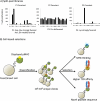Diversity-oriented approaches for interrogating T-cell receptor repertoire, ligand recognition, and function
- PMID: 23046124
- PMCID: PMC3474532
- DOI: 10.1111/imr.12006
Diversity-oriented approaches for interrogating T-cell receptor repertoire, ligand recognition, and function
Abstract
Molecular diversity lies at the heart of adaptive immunity. T-cell receptors and peptide-major histocompatibility complex molecules utilize and rely upon an enormous degree of diversity at the levels of genetics, chemistry, and structure to engage one another and carry out their functions. This high level of diversity complicates the systematic study of important aspects of T-cell biology, but recent technical advances have allowed for the ability to study diversity in a comprehensive manner. In this review, we assess insights gained into T-cell receptor function and biology from our increasingly precise ability to assess the T-cell repertoire as a whole or to perturb individual receptors with engineered reagents. We conclude with a perspective on a new class of high-affinity, non-stimulatory peptide ligands we have recently discovered using diversity-oriented techniques that challenges notions for how we think about T-cell receptor signaling.
© 2012 John Wiley & Sons A/S.
Figures




References
-
- Davis MM, Bjorkman PJ. T-cell antigen receptor genes and T-cell recognition. Nature. 1988;334:395–402. - PubMed
-
- Rudolph MG, Stanfield RL, Wilson IA. How TCRs bind MHCs, peptides, and coreceptors. Annu Rev Immunol. 2006;24:419–466. - PubMed
-
- Irvine DJ, Purbhoo MA, Krogsgaard M, Davis MM. Direct observation of ligand recognition by T cells. Nature. 2002;419:845–849. - PubMed
Publication types
MeSH terms
Substances
Grants and funding
LinkOut - more resources
Full Text Sources
Other Literature Sources

